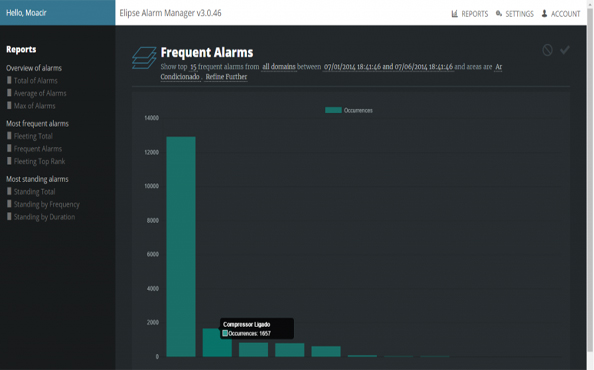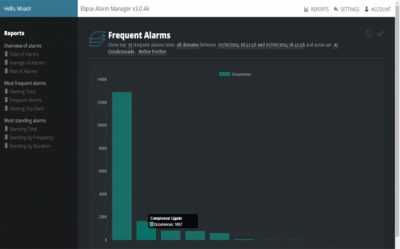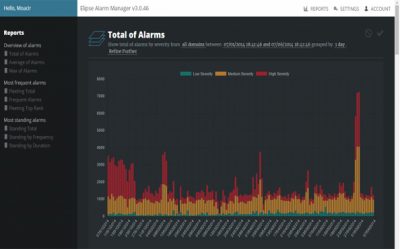- Tổng quan Specs Details Overview Components Packages Resources Additional Modules Complementary products Architecture Tools Benefits Features Customer Ordering
- Thành phần Specs Details Overview Components Packages Resources Additional Modules Complementary products Architecture Tools Benefits Features Customer Ordering
- Lợi ích Specs Details Overview Components Packages Resources Additional Modules Complementary products Architecture Tools Benefits Features Customer Ordering
Operate your process more efficiently with Elipse Alarm Manager.
The boom in connected devices and the growing amount of information that require real-time monitoring have an unfortunate byproduct: more and more alarms are being created in supervisory systems, which overwhelm operators and increase the likelihood of accidents and of physical, financial, and environmental risks.
Current scenario
Currently, alarm management problems are a common issue in facilities and management rooms. The main causes for them are:
- Alarms are indiscriminately created in SCADA systems, abiding to no corporate policies;
- Operators are burdened with a large amount of alarms whose levels of urgency are not easily distinguishable from one another;
- Many operators have to respond to over 1200 alarms per day.
When used to their fullest capacity, alarms should help operators detect failures in the process and then fix them, and not simply indicate variables in isolation.
Alarm floods
They can happen for a lot of reasons, such as:
- Alarms being added in excess to the system;
- Changes to processes and devices;
- Poorly designed alarms;
- Obsolete, decayed equipment;
- Temporal changes in the process, such as unplanned downtime;
- Many times, alarm development and management are not contemplated by the work process or the system administration.
The need for alarm management
Alarm management is usually necessary in situations including, but not limited to:
- Improving the operators’ labor conditions and their workload;
- Improving the system’s reliability;
- Ensuring better environmental and security conditions;
- Preventing unplanned stops or interruptions in the system;
- Fomenting operational efficiency and stability, and maximizing financial return.
Elipse Alarm Manager (EAM)
The Elipse Alarm Manager (EAM) is a platform developed to help manage the alarms’ data mining and research lifecycle, in order to point out what needs to be changed in the alarms’ baseline to get optimal system behavior.
Its reporting tool allows analyzing the alarms’ key performance indicators over time, such as how many alarms are being generated per day or per hour in the system as a whole or in certain areas of the process, and then determine whether operators are being overloaded with alarms at any given period. From there, the information can be drilled down to determine which alarms occur more frequently, which ones remain stable, and which ones are not being attended to as often as needed and therefore are active for too long or take too long to be acknowledged.
Its report data analyses can help spot which devices are faulty or poorly set up, and which ones need to adequate to changes in the process.
The Elipse Alarm Manager comprises three programs: Collector, Server, and Client.
The EAM Collector is usually installed in the same computer and/or network as the SQL Server database storing the Elipse E3/Power alarms. The Collector reads the data in this DB and sends it to the EAM Server through firewalls.
The EAM Server processes the alarms sent by the Collector, normalizes them, and saves them in a Data Warehouse (database designed specifically for reports). In addition to converting and saving this data, the Server offers an API REST that can generate reports in JSON format via HTTP requests. The competitive edge in this case is that the EAM can be integrated to other systems or reporting tools such as Microsoft Power BI ® or SQL Server Reporting Services ® (SSRS). Its client program also uses the same services, and all reports and resources offered by the Server are displayed in a friendly, efficient, multi-platform interface.
The EAM Client is the responsive web program, compatible with all top browsers in the market (Chrome®, Mozilla Firefox®, Internet Explorer® 10+). With the Client, you can access all reports available in the Server anywhere and via many different devices, such as tablets, desktops, notebooks, smartphones, and smart TVs.
Faster analyses anytime, anywhere
The Elipse Alarm Manager’s latest version has been totally redesigned to work in all main browsers in the market and fit all screen sizes, from smartphones to smart TVs. Additionally, its modern, high-performance interface can generate reports ten times faster in a productive environment for the analyst.
This new version’s Data Warehouse keeps data normalized, which enhances your reporting generation’s performance. Once the Collector is installed, both programs (Collector and Server) will run side by side to mine data and optimize reports in order to make sure your analyses are more efficient.
With the new EAM search criteria tool, you can browse multiple Elipse domains at once in a concise interface, designed to make you focus only on significant information for your process.
Try out Elipse Alarm Manager
Click https://eam.elipse.com.br:8080 and use email demo@elipse.com.br and password demo.




